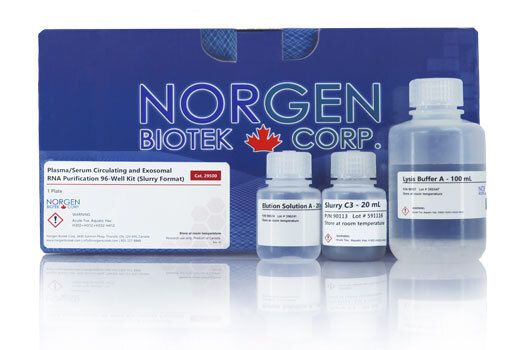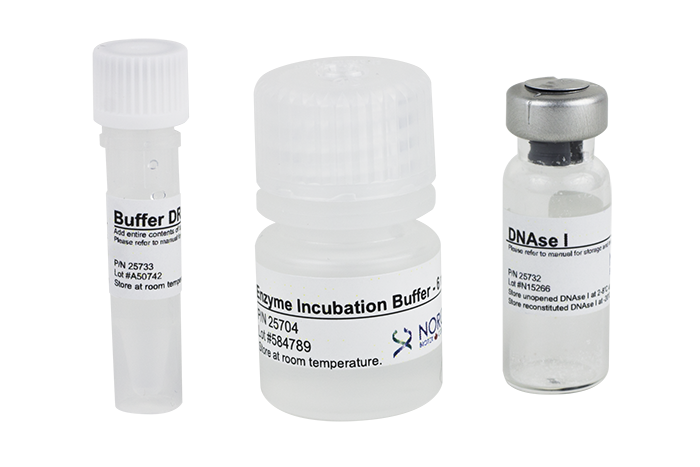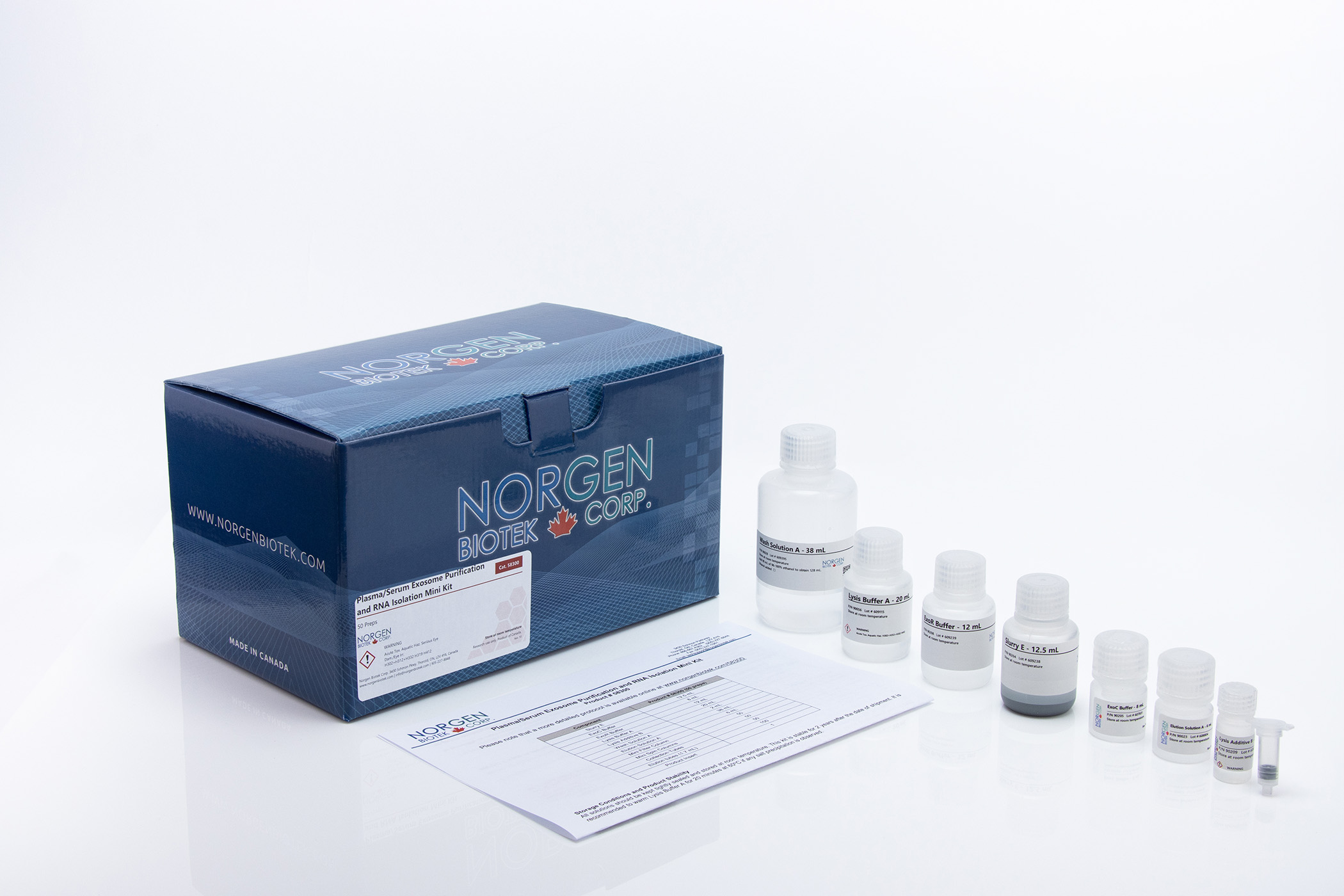Plasma/Serum Circulating and Exosomal RNA Purification Kits (Slurry Format)

For research use only and NOT intended for in vitro diagnostics.
Plasma/Serum Circulating and Exosomal RNA Purification Kits (Slurry Format)
Register today to receive an exclusive 15% off* on your first order.
Supporting Data
Figure 1. Isolation and Detection of Circulating RNA from Different Plasma Volumes. Norgen's Plasma/Serum Circulating RNA Purification Mini Kit (Slurry Format) was used to isolate circulating RNA from 0.5mL, 1mL and 2mL plasma. Three microlitres of the purified RNA was then used as the template in RT-qPCR reactions to detect the human 5S gene. The 5S housekeeping gene was detected from all plasma sample volumes used. The amplification of the 5S rRNA showed an increasing amount of RNA with increasing the sample input volume. This is represented by the decrease of the Ct value with increasing the sample input volume. RNA isolated from 0.5mL plasma is represented by the Red line, RNA isolated from 1mL plasma is represented by the Green line whereas RNA isolated from 2mL plasma is represented by the Blue line. The black line corresponds to the no template control.
Figure 2. Effective Isolation of Plasma Circulating RNA from Different Volumes. Norgen's Plasma/Serum Circulating RNA Purification Mini Kit (Slurry Format) was used to isolate circulating RNA from 0.5mL, 1mL and 2mL plasma. Three microlitres of the purified RNA was then used as the template in RT-qPCR reactions to detect the human 5S gene. The 5S housekeeping gene was detected from all plasma sample volumes used. The amplification of the 5S rRNA showed an increasing amount of RNA with increasing the sample input volume. This is represented by the decrease of the Ct value with increasing the sample input volume. Average Ct. values for the amplification of the 5S rRNA isolated from 0.5mL plasma is represented by the Red bar, Average Ct. values for the amplification of the 5S rRNA isolated from 1mL plasma is represented by the Green bar whereas Average Ct. values for the amplification of the 5S rRNA isolated from 2mL plasma is represented by the blue bar.
Figure 3. Effective and Consistent Detection of Plasma Exosome RNA. Norgen's Plasma/Serum Circulating and Exosomal RNA Isolation Kits can effectively isolate RNA from plasma. Plasma Exosome RNA was isolated from 500 µL of human plasma prepared from blood collected on citrate, EDTA or Heparin in triplicates using Norgen's Plasma/Serum RNA Isolation Kit (blue), a ExoQuick Exosome Precipitation Reagent (green) and Qiagen’s QIAzol extraction followed by a modified Qiagen's RNeasy Mini Kit cleanup (red). Stem loop RT-qPCR using primers specific to miR-21 and miR-16 as well as the housekeeping 5S rRNA was performed. In brief, three microliters of the 100 µL isolated RNA was then subjected to a 20 µL reverse transcription using 5S rRNA, miR-21 and miR-16 stem-loop reverse primer or reveres primer. Three microliters of the reverse transcription was used in a 20 µL real-time PCR reaction with primers to detect the human miR-21, human miR-16 and the 5S rRNA. Norgen's Plasma/Serum Exosome RNA Isolation Kit is the only product that showed consistent detection of all tested transcripts with the highest quality regardless the type of the anti-coagulant used for blood collection.
Figure 4. Isolation and Detection of Circulating RNA from Different Plasma Volumes. Norgen's Plasma/Serum Circulating RNA Purification Maxi Kit (Slurry Format) was used to isolate circulating RNA from 2mL, 3mL and 5mL plasma. Three microlitres of the purified RNA was then used as the template in RT-qPCR reactions to detect the human 5S gene. The 5S housekeeping gene was detected from all plasma sample volumes used. The amplification of the 5S rRNA showed an increasing amount of RNA with increasing the sample input volume. This is represented by the decrease of the Ct value with increasing the sample input volume. RNA isolated from 2mL plasma is represented by the Red line, RNA isolated from 3mL plasma is represented by the Green line whereas RNA isolated from 5mL plasma is represented by the Blue line. The black line corresponds to the no template control.
Figure 5. Effective Isolation of Plasma Circulating RNA from Different Volumes. Norgen's Plasma/Serum Circulating RNA Purification Maxi Kit (Slurry Format) was used to isolate circulating RNA from 2mL, 3mL and 5mL plasma. Three microlitres of the purified RNA was then used as the template in RT-qPCR reactions to detect the human 5S gene. The 5S housekeeping gene was detected from all plasma sample volumes used. The amplification of the 5S rRNA showed an increasing amount of RNA with increasing the sample input volume. This is represented by the decrease of the Ct value with increasing the sample input volume. Average Ct. values for the amplification of the 5S rRNA isolated from 2mL plasma is represented by the Red bar, Average Ct. values for the amplification of the 5S rRNA isolated from 3mL plasma is represented by the Green bar whereas Average Ct. values for the amplification of the 5S rRNA isolated from 5mL plasma is represented by the blue bar.
|
Kit Specifications - Spin Column
|
|
|
Minimum Plasma/Serum Input
|
0.25 mL
|
| Maximum Plasma/Serum Input |
2 mL
|
| Size of RNA Purified |
All sizes, including
microRNA |
| Time to Complete Purification |
< 40 minutes
|
Cat.51000 Storage Conditions and Product Stability
It is recommended to warm up Slurry C1 and Lysis Buffer A for 20 minutes at 60°C if any salt precipitation (crystallization) is observed. Slurry C1 contains grey resin that will not disappear by warming up.
| Component | Cat. 51000 (50 preps) | Cat. 29500 (96 preps) | Cat. 42800 (50 preps) | Cat. 50900 (25 preps) |
|---|---|---|---|---|
| Slurry C1 | - | - | - | 6 mL |
| Slurry C2 | 12 mL | - | 12 mL | - |
| Slurry C3 | - | 20 mL | - | - |
| Lysis Buffer A | 2 x 130 mL | 4 x 100 mL | 2 x 130 mL | 2 x 130 mL |
| Wash Solution A | 38 mL | 2 x 38 mL | 38 mL | 18 mL |
| Elution Solution A | 6 mL | 20 mL | 6 mL | 6 mL |
| Mini Filter Spin Columns | 50 | - | 50 | 25 |
| 96-Well Filter Plate | - | 1 | - | - |
| Adhesive Tape | - | 1 | - | - |
| Collection Tubes | 50 | - | 50 | 25 |
| 96-Well Collection Plate | - | 1 | - | - |
| Elution Tubes (1.7 mL) | 50 | - | 50 | 25 |
| 96-Well Elution Plate | - | 1 | - | - |
| Product Insert | 1 | 1 | 1 | 1 |
Documentation
42800 - Plasma_Serum Circulating and Exosomal RNA Purification Kit (Slurry Format) - SDS
29500 - Plasma_Serum Circulating and Exosomal RNA Purification 96-Well Kit (Slurry Format) - SDS
50900 - Plasma_Serum Circulating and Exosomal RNA Purification Maxi Kit (Slurry Format) - SDS
FAQs
Mini Slurry
Slurry
High Throughput Slurry
- There was an insufficient vacuum. Ensure that a vacuum pressure of at least -650 mbar or -25 inHg is developed
- The centrifuge temperature was too low. Ensure that the centrifuge remains at room temperature throughout the procedure. Temperatures below 15°C may cause precipitates to form that can cause the wells to clog.
- RNase contamination
RNases may be introduced during the use of the kit. Ensure proper procedures are followed when working with RNA. Please refer to “Working with RNA” at the beginning of the protocol's user guide.
- Procedure not performed quickly enough
In order to maintain the integrity of the RNA, it is important that the procedure be performed quickly



